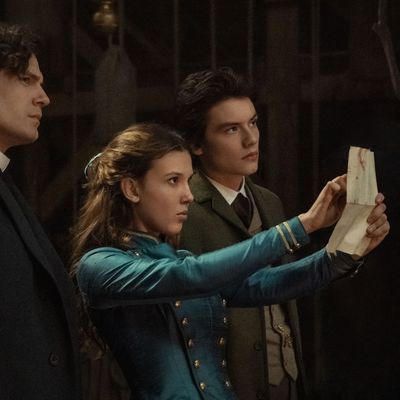
With the first Enola Holmes film, which came out on Netflix in the dark days of 2020, Millie Bobby Brown proved that she could power an entire feature through the sheer force of her charisma. As Sherlock Holmes’s often resourceful, occasionally reckless teenage sister — a noncanonical character created by novelist Nancy Springer in 2006 — the young actress blazed through a ho-hum mystery, one whose tepid twists and simple solutions actually enhanced her glow. We didn’t really have to focus on the specifics of the case (who the hell even had the mental energy to do so at the time?), so we could simply enjoy Brown’s performance, all smiles, darting eyes, and cheeky asides to the audience. The movie wasn’t particularly inventive, but its star was.
That first film followed a very green Enola as she investigated the disappearance of her headstrong mom (Helena Bonham Carter), and the movie turned largely on its protagonist’s naïveté. We could experience this stuffy Victorian world through her innocent, occasionally thunderstruck perspective. Enola Holmes 2 finds our heroine opening her own detective agency, with hopes of one day matching the success of her brother Sherlock (played again by Henry Cavill). One might say that this new film attempts to be something closer to a standard-issue mystery, with its ornate story line, ambitious action scenes, and historically resonant milieu. But in the end, it still thrives or dies on its teenage star’s charm. It mostly thrives, even if the luster is a bit off this time around.
Enola’s latest case is yet again a missing-persons affair, now involving the disappearance of a young woman named Sarah Chapman (Hannah Dodd), who worked at a huge match factory by day and a dance hall by night. Venturing undercover into the crowded, typhoid-ravaged warehouse where Sarah labored away at her grueling assembly-line job, Enola immediately begins to suspect that her disappearance had something to do with nefarious goings-on at the match factory. Naturally, Sherlock himself is also gradually drawn into the situation, and Cavill continues to make the most of his wink-wink miscasting — playing the famously cerebral, unstacked detective as a terse, brainy, burly bruiser. Also joining the festivities this time is a very game David Thewlis, chewing scenery as a snarling, sinister Scotland Yard commissioner who doesn’t even try to hide his contempt for Enola.
So the performances remain charming — Bonham Carter also returns for a brief action interlude — and the film, for all its narrative ambitions, seems to understand that its strength lies in its cast, particularly its lead. Brown isn’t quite the wide-eyed wonder of the last film, in which her youthful ignorance and exuberance were her great weapons. But the actress continues to draw humor from the intersection between the arcane and the modern. Her anachronistic mannerisms come across not as precious, eager-to-please ploys for audience approval, but rather as unguarded moments: Enola is still a kid trying to keep it together, and often failing to — she breaks, in other words, but she breaks in character. A scene where Enola is caught mid-cake-bite while semi-stalking her parliamentarian crush, Tewkesbury (Louis Partridge), is hilarious in its constant seesawing between propriety and desperation. An undercover foray into an elegant society ball (yes, we get another delightfully needless “’Tis I!” unmasking) finds Enola struggling to understand the secret language of hand fans and awkwardly attempting to converse with a man who is her prime suspect.
The strength and energy of Brown’s performance even helps paper over director Harry Bradbeer’s somewhat choppy, breathless direction. He cuts all his scenes too fast, as if worried that we might get tired of all this Victoriana he’s clearly spent tons of time and money re-creating. But atmosphere was never really part of the purchase order, was it? Bradbeer also directed Fleabag, and he’s there primarily to shine a light on the central, fourth-wall-breaking performance, a duty he accomplishes ably and effectively.
And maybe the swift, “never dwelling on anything” pace of the picture works in another regard. Attempts to add au courant touches to these types of stories can often turn extremely annoying extremely quickly (and there will surely be those for whom the Enola Holmes movies will feel like cynical attempts to fuse Gen-Z attitude with period atmosphere). The first film had a lightly contemporary political edge, situating Enola in a diversely cast world of parliamentary reformers and ass-kicking women’s-rights activists. The new one goes even further: The capitalistic cruelty of the match factory makes an impression on Enola and on us; it’s poignant that the person who’s hired her to solve this case in the first place is Sarah’s younger sister, Bessie (Serrana Su-Ling Bliss), herself a destitute match-factory girl without a penny to her name. But the movie also moves; it knows not to take itself too seriously, and never feels like a holier-than-thou lecture about the Bad Old Days. For all its narrative ornamentation and socially conscious grace notes, Enola Holmes 2 is still basically a kids’ movie about a smart and plucky girl who solves crimes. And what kind of fussbudget could have a problem with that?
More Movie Reviews
- The Accountant 2 Can Not Be Taken Seriously
- Another Simple Favor Is So Fun, Until It Gets So Dumb
- Errol Morris Has Been Sucked Into the Gaping Maw of True Crime


